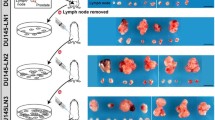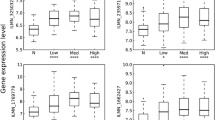Abstract
To understand alterations to the urokinase system that may occur in progressively metastatic prostate cancer cells, we assessed urokinase plasminogen activator receptor (uPAR) expression, in vitro motility towards vitronectin, urokinase plasminogen activator (uPA)-induced growth and growth factor regulation of uPAR expression in three cell lines—PC-3 and two derivatives from secondary metastases, PC-3M and PC-3MM2. DU-145 and Tsu-Pr1 cells were included for comparative purposes. uPAR expression increases with metastatic passage in these cell lines and accompanies increased growth and motility responses in the presence of uPA. Growth factors TGFβ1 and IGF-1 induce uPAR in all three prostate cancer lines; however, PC-3M and PC-3MM2 cells also respond to bFGF. Of the cell lines tested, PC-3MM2 most uniformly respond to added TGFβ1, IGF-1 and bFGF. These results show that in two progressive derivatives from repeated metastasis of PC-3 cells, constitutive and growth factor-induced uPAR expression is enhanced. This increased uPAR facilitates the properties of growth and motility.




Similar content being viewed by others
References
Berger D (2002) Plasmin/plasminogen system in colorectal cancer. World J Surg 26:767–771
Biliran H, Sheng S (2001) Pleiotrophic inhibition of pericellular urokinase-type plasminogen activator system by endogenous tumor suppressive maspin. Cancer Res 61:8676–8682
Bissell MJ, Le Beyec J, Anderson RL (2002) Prostate cancer in bone: importance of context for inhibition of matrix metalloproteinases. J Natl Cancer Inst 94:4–5
Bubendorf L, Schopfer A, Wagner U, Sauter G, Moch H, Willi N, Gasser TC, Mihatsch MJ (2000) Metastatic patterns of prostate cancer: an autopsy study of 1,589 patients. Hum Pathol 31:578-83
Delworth MG, Nishioka K, Pettaway CA, Gutman M, Killion JJ, Von Eschenbach AC, Fidler IJ (1995) Systemic administration of 4-amidinoindanon-1-(2′-amidino)-hydrazone, a new inhibitor of S-adenosylmethionine decarboxylase, produces cytostasis of human prostate cancer in athymic nude mice. Int J Oncol 6:293–299
Evans CP, Elfman F, Parangi S, Conn M, Cunha G, Shuman MA (1997) Inhibition of prostate cancer neovascularization and growth by urokinase-plasminogen activator receptor blockade. Cancer Res 57:3594–3599
Festuccia C, Dolo V, Guerra F, Violini S, Muzi P, Pavan A, Bologna M (1998) Plasminogen activator system modulates invasive capacity and proliferation in prostatic tumor cells. Clin Exp Metastasis 16:513–528
Greene GF, Kitadal Y, Pettaway CA, Von Eschenbach AC, Bucana CD, Fidler IJ (1997) Correlation of metastasis-related gene expression with metastatic potential in human prostate carcinoma cells implanted in nude mice using an in situ messenger RNA hybridization technique. Am J Pathol 150:1571–1582
Hollas W, Hoosein N, Chung LWK, Mazar A, Henkin J, Kariko K, Barnathan ES, Boyd D (1992) Expression of urokinase and its receptor in invasive and non-invasive prostate cancer cell lines. Thrombo Haemost 68:662–666
Hoyer-Hansen G, Behrendt N, Ploug M, Dano K, Preissner KT (1997) The intact urokinase receptor is required for efficient vitronectin binding: receptor cleavage prevents ligand interaction. FEBS Lett 420:79–85
Miyake H, Hara I, Yamanaka K, Gohji K, Arakawa S, Kamidono S (1999) Elevation of serum levels of urokinase-type plasminogen activator and its receptor is associated with disease progression and prognosis in patients with prostate cancer. Prostate 39:123–129
Pettaway CA, Pathak S, Greene G, Ramirez E, Wilson MR, Killion JJ, Fidler IJ (1996) Selection of highly metastatic variants of different human prostatic carcinomas using orthotopic implantation in nude mice. Clin Cancer Res 2:1627–1636
Rabbani SA, Gladu J (2002) Urokinase receptor antibody can reduce tumor volume and detect the presence of occult tumor metastases in vivo. Cancer Res 62:2390–23970
Rabbani SA, Xing RH (1998) Role of urokinase (uPA) and its receptor (uPAR) in invasion and metastasis of hormone-dependent malignancies. Int J Oncol 12:911–2
Sehgal I, Forbes K, Webb M (2003) Reduced expression of MMPs, plasminogen activators and TIMPS in prostate cancer cells during repeated metastatic selection. Anticancer Res 23: (in press)
Thalmann GN, Anezinis PE, Chang SM, Zhau HE, Kim EE, Hopwood VL, Pathak S, Von Eschenbach AC, Chung LW (1994) Androgen-independent cancer progression and bone metastasis in the LNCaP model of human prostate cancer. Cancer Res 54:2577–81
Thompson TC, Timme TL, Sehgal I (1998) Oncogenes, growth factors, and hormones in prostate cancer. In: Dickson RB, Salomon DS (eds) Hormones and growth factors in development and neoplasia. Wiley-Liss, New York, pp 327–359
Varkarakis MJ, Winterberger AR, Gaeta J, Moore RH, Murphy GP (1974) Lung metastases in prostate carcinoma. Urology 3:447–452
Von Bokhoven A, Garcia MV, Korch C, Miller, GJ (2001) TSU-Pr1 and JCA-1 cells are derivatives of T24 bladder carcinoma cells and are not of prostatic origin. Cancer Res61:6340–6344
Webb CP, Hose CD, Koochekpour S, Jeffers M, Oskarsson M, Sausville E, Monks A, Vande Woude GF (2000) The geldanamycins are potent inhibitors of the hepatocyte growth factor/scatter factor-met-urokinase plasminogen activator-plasmin proteolytic network. Cancer Res 60:342-349
Acknowledgements
This work was supported by funds from the NCRR (P20 RR15566), NCI (R15 CA-82139), the Fraternal Order of Eagles and the Department of Defense (PC991403) to I.S.
Author information
Authors and Affiliations
Rights and permissions
About this article
Cite this article
Forbes, K., Gillette, K., Kelley, L.A. et al. Increased levels of urokinase plasminogen activator receptor in prostate cancer cells derived from repeated metastasis. World J Urol 22, 67–71 (2004). https://doi.org/10.1007/s00345-003-0395-3
Received:
Accepted:
Published:
Issue Date:
DOI: https://doi.org/10.1007/s00345-003-0395-3




